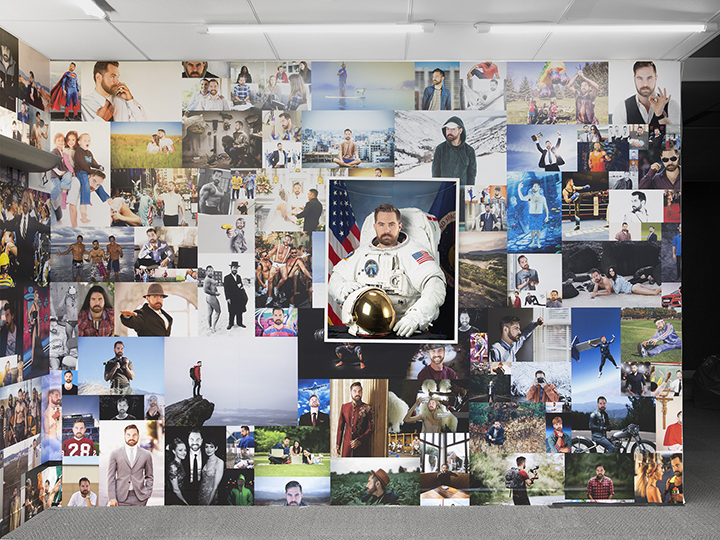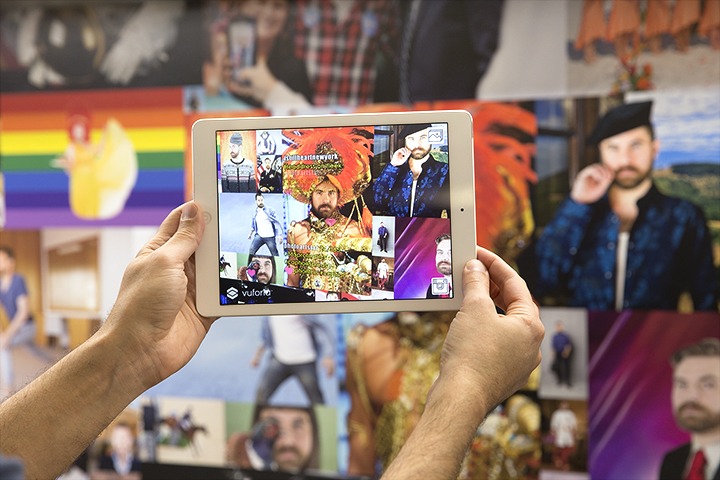FACING THE BLACK MIRROR: SEAN FADER’S AWESOME YEAR
BY ANDREA ALESSI
Oscar Wilde famously suggested great art “reveal beauty and hide the artist.” For the 2017 BLACK MIRROR exhibition at SPRING/ BREAK, more than 100 curators will feature artworks that explore the dance of identity the artist undergoes—between showing what’s unseen and hiding in plain sight—especially in the face of modern technology, political unrest, and glimmers from ghosts of Art History’s past.
ArtSlant will be exhibiting the ArtSlant Prize 2016 Winners at SPRING/BREAK. In expectation of this uniquely site-specific, curatorial fair, we’re featuring interviews with participating curators and artists, asking them what they see reflected in the black mirror.
Previous interviews: Eve Sussman and Simon Lee on curating Jack & Leigh Ruby, Janusz Jaworski on chashama, and Michael Holman

If the original black mirror, the Claude glass, hid the artist to reveal the idealized subject, then Sean Fader’s 365 Profile Pics is its modern day progeny indeed. Despite comprising some 365 images of the artist’s face, the expansive artwork reveals very little about Fader himself, turning its lens instead onto contemporary culture, image making, and consumption.
Every day for a year, Fader has uploaded a new profile picture on Instagram, Facebook, and Twitter. Using sites like Fiverr and Craigslist, the artist hired image retouchers from around the world to fabricate profile pics for him, pulling from 400 green-screened selfies and instructions to “make me look amazing and my life look awesome.” Over the course of the year, posting a new pic each day, Fader encouraged captions and comments from his followers.
Through the exercise, Fader’s face became the medium through which others projected their ideas of awesomeness, individuality, or conformity. In concert, the images are a broad register of generic moments, surreal scenes, and cultural and political touchstones from the past year. Pouts and red flannel shirts abound, as do well-lit offices and tailored suits. The artist had brief stints as an astronaut and a mega-church preacher. He went surfing, walked some red carpets, and stood behind Melania Trump at the Inauguration.
At SPRING/BREAK, in a presentation by Denny Gallery, Fader transformed his year of profile pics into an ensemble wallpaper. An augmented reality app allows viewers to hover their phone over an image to see the social media comments it received over the past year and to contribute new ones. Like a proud voter fulfilling their civic duty, participating viewers walk away with an “I commented” sticker. Because there’s a little bit of us all reflected in Fader’s black mirror.

How does it feel having your likeness proliferated like this? Have you come to identify with these images?
My father wanted to direct movies and my mother was an amateur photographer, so I grew up thinking about my body as a stand-in or stage for many types of ideas. Until my mid-twenties I trained for a career in musical theater, so my view of my body and my performance of self were malleable. I did believe that there was a one “true” me that I was trying to reveal, but as a performer I also believed that I could transcend myself for the “character.” So many of the Seans you see in this project are characters of someone. Whenever I would get an email with an image of me that seemed exciting, I did feel excited. Look, that’s me as an astronaut or a cowboy! Don’t I look like a good businessman, or a sad bro?
They all feel like me and yet they’re not me at all—but isn’t this what everyone is doing these days? People distill themselves into a snap, a gram, a tweet, or a status. These tiny bits are meant to project who they are, but in fact these images are and are not them.
When I started this project I was thinking a lot about the profile pic as a performance site. For instance, when a stranger emails me, I look them up on Facebook and I click as fast as I can through all of their profile pics, which is a little performance of their identity in a tiny square on my computer screen.

Talk to me about ownership.
It is so hard to think about authorship these days without viewing the Internet as a place where you can steal another’s work or be stolen from. In the United States (and the West) we value creativity as a commodity. We want to make one thing that we can get residuals from for the rest of our lives, and we want to claim things as our own. Funny thing, in the “Art World” much of the work is outsourced labor to studio assistants, fabricators, and craftsmen, but somehow because I didn’t take the picture or compose these images there is a question of authorship.
What’s your conception of the Black Mirror and how do you see 365 Profile Pics engaging with it?
Honestly when I read the concept text for SPRING/BREAK this year I thought, OMG I think they are writing about my work. I mean…
Innovation has enhanced the way in which the self is documented, exhumed, and proliferated on the day-to-day. A “keeping up with the Joneses”–style attention to self-portraiture on social media, an embrace of video communication software in the live stream, even the self grooming to meet standards of omnipresent surveillance documentation, or bystander photo-bomb, all keep us constantly rebounding from our subjective experiences back to a meditation on the “me.”
In addition to being obsessed with the performance of the profile pic, I was also looking at how people cultivate fame in social media and how we are outsourcing much of that work. Today celebrities and brands have people that manage their social media accounts; sites like Fiverr are dedicated to retouching people’s photographs for five bucks, you can buy followers; there are social media analytics companies; and there are PR firms that only work in social media. I wanted to use these very same mechanisms in this project, so I decided to outsource the PR of my own identity on Fiverr. I would pay anyone who was interested to take a crack at it. What is the most important thing in social media? To look amazing and to make your life look awesome, so those were my instructions for the retouchers.
What’s the role of the online viewer, and how crucial is a commenting social media community to realizing this project?
I’m a huge fan of Cécile B. Evans so I feel like the answer is “Hyperlinks or it didn’t happen” (an amazing piece of hers). Look at Google: their algorithm determines what we know about the world and is based on PageRank, the original algorithm that determines a website’s importance by the number and quality of links to a page. It’s all about connections. I really wanted to understand how the Internet’s hive mind thinks through images. Memes rise and fall in a day but hover in our subconscious, so people commenting in social media is a key component to the project. On the final page of the book I have a thank you page that lists everyone who made images and/or commented on social media. They are all part of this work and continue to be.
I have been feeling like these dual lives—social media and my studio practice—have been the same. The photo print on the wall and the photo shared on Instagram feel like they are parallel practices. I wanted to make the space of the exhibition the liminal space where these two practices collide, so I worked with Erin Ko and Alex Cuff to create an augmented reality. At SPRING/BREAK, people can download the PhotoArtStar app (named after my Insta handle) and point their iPhone at the images on the wall. For 100 of the photos, the app will pull all the Instagram comments on that image and will overlay them on top of the photo. You can also press a button to open that very image in your own Instagram. If you do that and comment, I will give you an “I commented” sticker for you to wear IRL. The stickers look very much like the “I voted” stickers from elections. I’m doing this because, first, I love giving things away. I also love the idea that participation and having your voice heard is a badge of pride, but this also has the angle of a marketing campaign. So it works both ways.
What are some of the weirdest moments you’ve experienced working on 365 Profile Pics? Were you ever uncomfortable with any of the retouched images?
I was disappointed by how many people depicted me with all the tropes of a straight white American man. You can see how deeply American mass media has penetrated the planet by how many of my retouchers assumed that is who I wanted to be. In many ways my prompt of make me look amazing and my life look awesome — combined with the availability of hi resolution stock photography — was intended to critically activate these stereotypes in order to address how they propagate heteonormativity, whiteness, and consumerism. Throughout mass media and visual culture, these circulate as assumptions what normalcy looks like, so I designed the prompt to draw to them surface and to allow us to critique them. The scale of the project (and its humor) mark these normally unmarked assumptions, and it challenges their power by making them ludicrous and revealing the clichés they rely on. By working with a global team of collaborators on this, I was able to show how widely these stereotypes circulate and how they have fed into a narrow and problematic stereotype of American culture. Any one of the images can be funny or innocuous, but 365 of them shows the force of these norms operating in visual culture. By visualizing them, we can turn that humor against them to reveal how hollow and fragile they really are.

Did you learn anything from working on this project for a year that you hadn’t anticipated at the beginning?
I was shocked people believed that these images were real. On Instagram we seem to suspend disbelief in this way. For those of us that grew up around computers, the idea of realness is no longer tied to an objective photographic reality in the traditional sense. We don’t look at an image and decide it is real because x, y, and z things were in front of a camera at a specific time and the camera shutter was pressed—the decisive moment. But it still was funny that people thought the images were real in this way.
The 365 Profile Pics don’t necessarily describe a traditional photographic reality but they are still real photographs because all of them do represent something. Many of us seem to be expanding what we think of as real and that is really exciting. I also love that the images on the Internet are small and digital and low-resolution so they actually look more convincing as decisive moments, and I continue to post pics of my own day between each of the profile pics so they even sit side by side. When you see them blown up and printed, the illusion of Photoshop composites often falls apart.
I also learned that outsourcing is really complicated. Many of the retouchers I worked with did not want to be creative. I gave them tech specs and total creative freedom, which made a lot of them angry. They wanted to be told exactly what to do and they wanted to execute it. They also didn’t want to follow my tech specs and kept telling me I didn’t need a high-res image, even when that was outlined in the original advertisement. I also spent so much time back-and-forth arguing with them that it would have taken me less time to do it myself. I felt bad about paying five dollars an image but felt gouged if they wanted 10. It churned up so much Western guilt and complex ideas about the global market and my idea of my position in it.
I was happy to find that lots of people loved this project, and getting to participate and comment was so much fun and funny.

